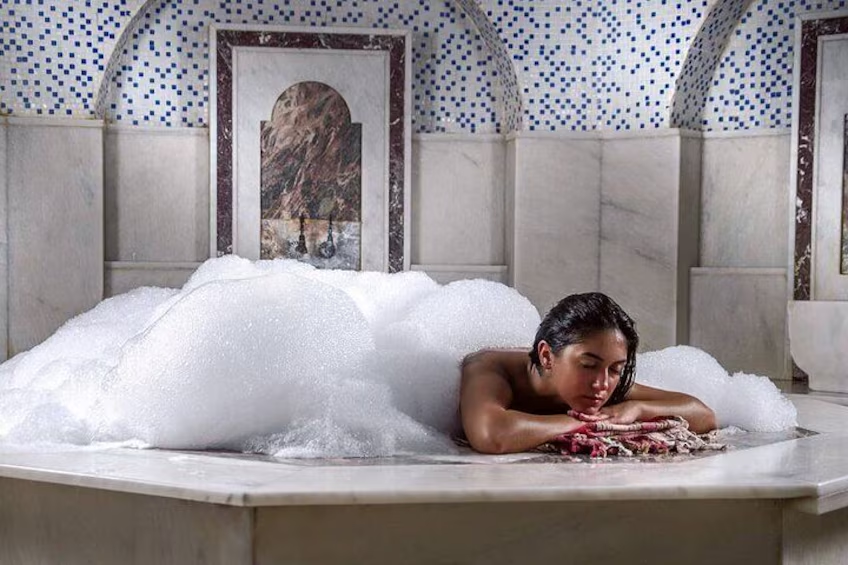If you find yourself exploring Istanbul, taking a break to experience a traditional Turkish bath or hammam, is a great way to experience the city’s cultural heritage. The hammam is not just a place for cleansing; it’s a social ritual that dates back centuries. For digital nomads needing a break or tourists who want to indulge in a local tradition, a Turkish bath offers relaxation and cultural immersion in equal measure.
What is a Turkish Bath?
A Turkish bath, known locally as a hammam, is a type of public bathing facility that combines heat, steam, and massage in a ritualized process. The concept evolved from Roman bathhouses and was refined during the Ottoman era, becoming a key element of social life in the Islamic world. It serves as a place for both physical cleansing and social interaction, often featuring stunning architecture and elaborate tile work.
What is the Difference Between a Turkish Bath and a Hammam?
There is no difference between a Turkish bath and a hammam; the terms are used interchangeably. “Hammam” is derived from the Arabic word “ham,” meaning “heat,” which accurately describes the central feature of these baths. Turkish bath is the Western term that highlights the location and cultural context of this practice. Both terms refer to the same traditional bathing experience.
What Happens During a Turkish Bath?
A traditional Turkish bath experience unfolds in several stages:
- Warm-Up: You begin by relaxing in a warm room to allow your body to adjust to the heat.
- Steam: After warming up, you move to a steam room to open your pores and begin the cleansing process.
- Scrubbing: An attendant uses a rough exfoliating mitt called a kese to scrub your skin, removing dead cells and impurities.
- Rinsing and Massage: You are then rinsed off and may receive a foam massage with soap, followed by a final rinse.
- Cool-Down: The experience typically concludes with a period of relaxation in a cooler area.
What All Does a Turkish Bath Involve?
A Turkish bath involves a cleansing ritual that includes:
- Relaxation: Sitting or lying on a heated marble platform to acclimate to the warmth.
- Exfoliation: Using a kese (exfoliating mitt) to scrub the skin and remove dead cells.
- Soap Foam Massage: A luxurious massage with bubbles created from a special soap, designed to relax and cleanse.
- Rinsing: A thorough rinse to remove all soap and impurities.
- Resting: Spending some time in a cooler area to allow your body to normalize after the heat.
What is So Special About a Turkish Bath?
The uniqueness of a Turkish bath lies in its of historical tradition, architectural beauty, and the deeply relaxing experience it offers. Hammam rituals are steeped in centuries of tradition, and the architectural settings, are adorned with intricate tile work and grand domes. The experience is both physically and culturally enriching, offering a moment of calm and reflection in the middle of a busy travel schedule.
Are Turkish Baths Healthy?
Yes, Turkish baths offer several health benefits:
- Relaxation: The heat helps to relax muscles and ease tension.
- Detoxification: Sweating in the steam room aids in flushing out toxins.
- Improved Circulation: The heat helps improve blood flow and circulation.
- Skin Health: The exfoliation process removes dead skin cells, leaving the skin smooth and rejuvenated.
However, it is important to note that those with certain medical conditions, such as cardiovascular issues, should consult their doctor before participating.
Are Turkish Baths Hygienic?
Turkish baths are generally well-maintained and adhere to high standards of hygiene. Facilities are cleaned regularly, and the high temperatures and steam contribute to a hygienic environment. However, as with any public space, it’s important to choose a reputable hammam and follow personal hygiene practices.
Are Turkish Baths Safe?
Turkish baths are safe for most people. The heat and steam can be beneficial, but individuals with specific health concerns, such as heart conditions or respiratory issues, should consult with a healthcare provider beforehand. Additionally, it’s crucial to listen to your body, stay hydrated, and avoid prolonged exposure to high temperatures.
Can Women Have a Turkish Bath?
Yes, women can and do enjoy Turkish baths. Many hammams offer separate facilities or designated times for women to ensure privacy. Some modern establishments may also have mixed-gender areas or allow women to use private rooms.
Do You Wear Clothes in a Turkish Bath?
Traditionally, you wear a pestemal, a thin towel-like cloth wrapped around the waist. This practice maintains modesty while allowing ease of movement. In some modern hammams, you may see people wearing swimwear, but this varies depending on the establishment’s rules.
Do You Wear a Bra to a Hammam?
It is generally not necessary to wear a bra to a hammam. Most people opt for minimal clothing, such as a pestemal or swimwear. If you have specific preferences, you can choose to wear a sports bra or a similar garment for comfort.
Do You Wear a Bathing Suit in a Turkish Bath?
In many traditional hammams, wearing a bathing suit is not customary. Instead, guests typically wear a pestemal. However, some modern establishments might allow or even encourage swimwear. It’s best to check the dress code of the hammam you plan to visit.
Can You Go to a Turkish Bath on Your Period?
It’s smart to avoid going to a Turkish bath during your period. If you need to visit, consider using a tampon and inform the staff if you have any specific needs. Some hammams may have policies regarding menstruation, so it’s best to check in advance.
Are Turkish Baths Rough?
The intensity of the experience can vary. The scrubbing and massage can be vigorous, but this is intended to be exfoliating and invigorating. If you prefer a gentler experience, you can communicate your preferences to the attendant.
What is a Pouch in a Hammam?
A pouch, or kese, is a rough-textured mitt used to exfoliate the skin. The pouch is rubbed over the body to remove dead skin cells and improve circulation, leaving the skin smooth and refreshed.
How Do You Enjoy a Turkish Bath?
To fully enjoy a Turkish bath:
- Relax: Take your time and let the warmth soothe your muscles.
- Communicate: Inform your attendant of any preferences or concerns.
- Hydrate: Drink water before and after your bath to stay hydrated.
- Be Open-Minded: Embrace the cultural experience and follow the rituals.
What Are the Rules for a Turkish Bath?
Common rules for Turkish baths include:
- Respect Privacy: Keep noise to a minimum and respect others’ privacy.
- Avoid Phones: Many hammams discourage phone use to maintain a tranquil atmosphere.
- Follow Dress Code: Adhere to the dress code, whether it’s a pestemal or swimwear.
- Maintain Hygiene: Wash thoroughly before entering communal areas.
Should I Shower After a Turkish Bath?
Yes, it’s a good idea to shower after your Turkish bath to rinse off any soap, sweat, or exfoliated skin. This helps maintain the skin’s natural balance and refreshes you after the experience.
What Not to Do After a Hammam
After a hammam, avoid:
- Hot Showers: They can disrupt your body’s natural cooling process.
- Strenuous Activity: Give your body time to cool down and relax.
- Alcohol: It can dehydrate you, so opt for water or herbal teas instead.
Turkish Bath Prices
Prices for Turkish baths can vary widely depending on the location, amenities, and level of luxury. You might pay between 100 to 500 TRY for a basic entry, with additional costs for extra services like massages, facials, or private rooms. Luxury hammams may charge more, reflecting their high-end services and facilities.
Do You Tip at a Turkish Bath?
Tipping is customary and appreciated in Turkish baths. It’s common to give a tip of around 10-15% of the service cost to attendants who provide scrubbing, massages, or other services.
Should I Shave Before a Turkish Bath?
It’s advisable to shave at least a day before visiting a Turkish bath to avoid skin irritation. Exfoliation and scrubbing can be harsh on freshly shaved skin.
Pros and Cons of Turkish Baths
Pros:
- Relaxation: Offers a deeply relaxing and soothing experience.
- Cultural Experience: Provides insight into traditional Turkish customs.
- Health Benefits: Promotes relaxation, improves circulation, and detoxifies the body.
Cons:
- Intensity: The experience can be intense or overwhelming for some.
- Crowds: Popular hammams can be busy, impacting the experience.
- Language Barriers: Communication might be challenging in some places.
Turkish Bath Benefits
Benefits of a Turkish bath include:
- Detoxification: Sweating helps eliminate toxins from the body.
- Skin Health: Exfoliation and cleansing improve skin texture and appearance.
- Relaxation: The heat and massage provide significant stress relief.
- Social Interaction: It’s a place to meet locals and fellow travelers in a communal setting.
Tips for Your Turkish Bath Experience
- Arrive Early: To avoid crowds and have a more relaxing experience.
- Stay Hydrated: Drink plenty of water before and after the bath.
- Communicate Needs: Let your attendant know if you have any preferences or concerns.
- Relax and Enjoy: Embrace the experience and take your time to fully enjoy the bath.
FAQs About Turkish Baths
What should I bring to a Turkish bath?
When visiting a Turkish bath, it’s important to bring a few key items. Generally, you’ll need a towel or pestemal (a traditional wrap), flip-flops or sandals for walking around, and a change of clothes for after the bath. Some hammams provide these items, but it’s always good to confirm beforehand. Additionally, bringing a water bottle to stay hydrated is a wise choice.
Can I use my phone in a Turkish bath?
Most Turkish baths discourage or prohibit the use of phones to maintain a peaceful and relaxing environment. It’s considered respectful to keep your phone off and avoid taking photos, especially in communal areas. If you need to stay connected, check if the hammam has designated areas where phone use is permitted.
How long should I stay in a Turkish bath?
The ideal duration for a Turkish bath experience is typically between 1 to 2 hours. This allows ample time to enjoy the warm-up, steam, scrubbing, and relaxation stages without feeling rushed. However, listen to your body and leave if you start to feel overheated or uncomfortable.
Can I eat before going to a Turkish bath?
It’s advisable to avoid eating a heavy meal immediately before your Turkish bath. A light snack an hour or two prior is generally fine. Eating a large or rich meal might make you feel uncomfortable during the bath, especially since the heat can intensify digestion.
What should I wear to a Turkish bath?
Traditional attire in a Turkish bath is the pestemal, a thin towel wrapped around the waist. This ensures modesty while allowing ease of movement. In some modern hammams, swimwear might be acceptable. Always check the specific dress code of the hammam you plan to visit to ensure you’re appropriately dressed.
Are Turkish baths co-ed?
Many traditional Turkish baths are gender-segregated, with separate facilities or times for men and women to ensure privacy. However, some modern hammams offer mixed-gender areas or private rooms that can be reserved for couples or groups. Check with the hammam beforehand to understand their policy.
Can I bring children to a Turkish bath?
Policies regarding children vary among hammams. Some establishments welcome children and have special facilities or times for families, while others may have age restrictions. It’s best to contact the hammam in advance to inquire about their policy on children.
How do I find a good Turkish bath?
Finding a reputable Turkish bath can be done by checking online reviews, asking locals for recommendations, or consulting travel guides. Look for hammams with a good reputation for cleanliness, service, and authenticity. Well-established baths with a long history or those located in popular tourist areas often offer reliable experiences.
What kind of soap is used in a Turkish bath?
Turkish baths often use a special lathering soap made from natural ingredients, designed to create rich, foamy bubbles for the soap massage. This soap is typically gentle on the skin and helps to cleanse and moisturize. In some baths, you may also have the option to choose from various scented or therapeutic soaps.
Can I book a private session in a Turkish bath?
Many hammams offer the option to book private rooms or sessions. This can provide a more personalized and secluded experience. To book a private session, contact the hammam in advance to check availability and make a reservation. Private rooms often come with additional services and amenities.
What if I don’t speak Turkish?
If you don’t speak Turkish, don’t worry. Many hammams have staff who speak English or other languages. It’s helpful to learn a few basic phrases or use a translation app to communicate your needs. Some establishments also provide information in multiple languages.
What kind of treatments are available in Turkish baths?
In addition to the standard bathing experience, many Turkish baths offer a range of treatments such as massages, facials, and aromatherapy. These services can enhance your bath experience and provide additional relaxation and rejuvenation. Check the hammam’s menu of services before you go.
Can I visit a Turkish bath if I’m pregnant?
Pregnant women should consult their healthcare provider before visiting a Turkish bath due to the heat and steam involved. Some hammams may offer alternative treatments or lower-temperature options, but it’s important to get medical advice to ensure it’s safe for you.
Are Turkish baths suitable for people with sensitive skin?
If you have sensitive skin, inform your attendant at the beginning of your session. Many hammams can accommodate specific needs by adjusting the intensity of the scrubbing or using milder soaps. It’s also advisable to avoid vigorous scrubbing and choose a gentle exfoliation option.
How do I make a reservation for a Turkish bath?
Reservations can often be made by calling the hammam directly, through their website, or via third-party booking platforms. For popular or high-end hammams, it’s a good idea to book in advance to secure your preferred time and date.
What should I do if I feel dizzy or unwell in the bath?
If you feel dizzy or unwell, immediately leave the heated area and sit in a cooler place. Drink plenty of water to rehydrate and allow your body to recover. If symptoms persist or worsen, seek assistance from the staff or medical help if necessary.
What are the typical etiquette and behavior expected in a Turkish bath?
Etiquette in a Turkish bath includes speaking softly, respecting others’ privacy, and following the bath’s rules. Avoid using your phone, ensure you wash thoroughly before entering communal areas, and be mindful of local customs and traditions. Showing respect and courtesy enhances the experience for everyone.
Final Thoughts About Turkish Baths
Experiencing a Turkish bath is a memorable way to enjoy a deeply relaxing and rejuvenating ritual. Whether you’re a digital nomad in need of a break or a tourist eager for a unique local experience, a visit to a hammam offers a blend of tradition, relaxation, and wellness that is truly special. Embrace the experience and follow the customs to enhance your Istanbul adventure.
Safe Travels!






